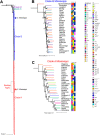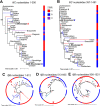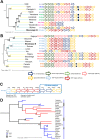Phylogeographic Clustering Suggests that Distinct Clades of Salmonella enterica Serovar Mississippi Are Endemic in Australia, the United Kingdom, and the United States
- PMID: 34550008
- PMCID: PMC8550085
- DOI: 10.1128/mSphere.00485-21
Phylogeographic Clustering Suggests that Distinct Clades of Salmonella enterica Serovar Mississippi Are Endemic in Australia, the United Kingdom, and the United States
Abstract
Salmonella enterica serovar Mississippi is the 2nd and 14th leading cause of human clinical salmonellosis in the Australian island state of Tasmania and the United States, respectively. Despite its public health relevance, relatively little is known about this serovar. Comparison of whole-genome sequence (WGS) data of S. Mississippi isolates with WGS data for 317 additional S. enterica serovars placed one clade of S. Mississippi within S. enterica clade B ("clade B Mississippi") and the other within section Typhi in S. enterica clade A ("clade A Mississippi"), suggesting that these clades evolved from different ancestors. Phylogenetic analysis of 364 S. Mississippi isolates from Australia, the United Kingdom, and the United States suggested that the isolates cluster geographically, with U.S. and Australian isolates representing different subclades (Ai and Aii, respectively) within clade A Mississippi and clade B isolates representing the predominant S. Mississippi isolates in the United Kingdom. Intraclade comparisons suggested that different mobile elements, some of which encode virulence factors, are responsible for the observed differences in gene content among isolates within these clades. Specifically, genetic differences among clade A isolates reflect differences in prophage contents, while differences among clade B isolates are due to the acquisition of a 47.1-kb integrative conjugative element (ICE). Phylogenies inferred from antigenic components (fliC, fljB, and O-antigen-processing genes) support that clade A and B Mississippi isolates acquired these loci from different ancestral serovars. Overall, these data support that different S. Mississippi phylogenetic clades are endemic in Australia, the United Kingdom, and the United States. IMPORTANCE The number of known so-called "polyphyletic" serovars (i.e., phylogenetically distinct clades with the same O and H antigenic formulas) continues to increase as additional Salmonella isolates are sequenced. While serotyping remains a valuable tool for reporting and monitoring Salmonella, more discriminatory analyses for classifying polyphyletic serovars may improve surveillance efforts for these serovars, as we found that for S. Mississippi, distinct genotypes predominate at different geographic locations. Our results suggest that the acquisition of genes encoding O and H antigens from different ancestors led to the emergence of two Mississippi clades. Furthermore, our results suggest that different mobile elements contribute to the microevolution and diversification of isolates within these two clades, which has implications for the acquisition of novel adaptations, such as virulence factors.
Keywords: Salmonella; phylogeography; polyphyly; prophage; whole-genome sequencing.
Figures






Similar articles
-
Salmonella enterica Phylogeny Based on Whole-Genome Sequencing Reveals Two New Clades and Novel Patterns of Horizontally Acquired Genetic Elements.mBio. 2018 Nov 27;9(6):e02303-18. doi: 10.1128/mBio.02303-18. mBio. 2018. PMID: 30482836 Free PMC article.
-
Phylogeny of Salmonella enterica subspecies arizonae by whole-genome sequencing reveals high incidence of polyphyly and low phase 1 H antigen variability.Microb Genom. 2021 Feb;7(2):000522. doi: 10.1099/mgen.0.000522. Microb Genom. 2021. PMID: 33539276 Free PMC article.
-
Genome sequencing reveals diversification of virulence factor content and possible host adaptation in distinct subpopulations of Salmonella enterica.BMC Genomics. 2011 Aug 22;12:425. doi: 10.1186/1471-2164-12-425. BMC Genomics. 2011. PMID: 21859443 Free PMC article.
-
The Number and Type of Chaperone-Usher Fimbriae Reflect Phylogenetic Clade Rather than Host Range in Salmonella.mSystems. 2022 Jun 28;7(3):e0011522. doi: 10.1128/msystems.00115-22. Epub 2022 Apr 25. mSystems. 2022. PMID: 35467401 Free PMC article. Review.
-
Embracing Diversity: Differences in Virulence Mechanisms, Disease Severity, and Host Adaptations Contribute to the Success of Nontyphoidal Salmonella as a Foodborne Pathogen.Front Microbiol. 2019 Jun 26;10:1368. doi: 10.3389/fmicb.2019.01368. eCollection 2019. Front Microbiol. 2019. PMID: 31316476 Free PMC article. Review.
Cited by
-
Isolation, susceptibility profiles and genomic analysis of a colistin-resistant Salmonella enterica serovar Kentucky strain COL-R.3 Biotech. 2023 May;13(5):140. doi: 10.1007/s13205-023-03559-2. Epub 2023 Apr 26. 3 Biotech. 2023. PMID: 37124985 Free PMC article.
-
Genomic diversity of Salmonella Typhimurium and its monophasic variant in pig and pork production in France.Microbiol Spectr. 2024 Nov 8;12(12):e0052624. doi: 10.1128/spectrum.00526-24. Online ahead of print. Microbiol Spectr. 2024. PMID: 39513704 Free PMC article.
-
Salmonella associated with agricultural animals exhibit diverse evolutionary rates and show evidence of recent clonal expansion.mBio. 2024 Oct 16;15(10):e0191324. doi: 10.1128/mbio.01913-24. Epub 2024 Sep 17. mBio. 2024. PMID: 39287448 Free PMC article.
-
What's on a prophage: analysis of Salmonella spp. prophages identifies a diverse range of cargo with multiple virulence- and metabolism-associated functions.mSphere. 2024 Jun 25;9(6):e0003124. doi: 10.1128/msphere.00031-24. Epub 2024 May 22. mSphere. 2024. PMID: 38775467 Free PMC article.
-
Development of a Genomics-Based Approach To Identify Putative Hypervirulent Nontyphoidal Salmonella Isolates: Salmonella enterica Serovar Saintpaul as a Model.mSphere. 2022 Feb 23;7(1):e0073021. doi: 10.1128/msphere.00730-21. Epub 2022 Jan 5. mSphere. 2022. PMID: 34986312 Free PMC article.
References
-
- Havelaar AH, Kirk MD, Torgerson PR, Gibb HJ, Hald T, Lake RJ, Praet N, Bellinger DC, de Silva NR, Gargouri N, Speybroeck N, Cawthorne A, Mathers C, Stein C, Angulo FJ, Devleesschauwer B, World Health Organization Foodborne Disease Burden Epidemiology Reference Group . 2015. World Health Organization global estimates and regional comparisons of the burden of foodborne disease in 2010. PLoS Med 12:e1001923. doi:10.1371/journal.pmed.1001923. - DOI - PMC - PubMed
Publication types
MeSH terms
Substances
LinkOut - more resources
Full Text Sources

